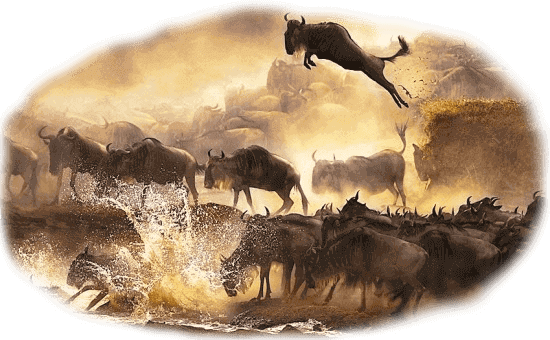Plan your Kenyan Tour and Trip Comfortably - Best Advice

Preparing for a safari trip to Kenya means weighing a lot of factors that might take a lot of your time. Why not talk to a resourceful local consultant like Homejoy Safari Adventures & get set up smoothly for your Kenya Safari tour?



Ensure to Make new discoveries and learn new things
A Guide to the Great Migration in Kenya: When and Where to See It
, Narok County
Kenya
The Great Migration is one of the world’s most breathtaking wildlife spectacles, captivating the attention of nature enthusiasts, photographers, and adventure seekers from around the globe. This extraordinary event sees millions of wildebeests, zebras, and gazelles traverse the Serengeti-Masai Mara ecosystem in search of fresh grazing lands, creating one of the largest and most dramatic movements of land animals on Earth. This incredible journey is fraught with peril as the herds must navigate treacherous river crossings, evade lurking predators, and withstand the harsh conditions of the African wilderness. Each year, visitors from the United States, the United Kingdom, Germany, France, and China make their way to Kenya to witness this unparalleled display of natural survival. The migration is not just about movement; it is a dramatic cycle of life and death, where the strong endure and the weak fall behind. Predators such as lions, cheetahs, hyenas, and crocodiles lie in wait, seizing opportunities presented by the sheer volume of prey. Watching this event unfold offers a front-row seat to the raw and unfiltered drama of nature. The spectacle of the Great Migration is not confined to a single moment but is a year-long phenomenon. While river crossings at the Mara River are among the most famous and sought-after experiences, other phases of the migration, such as the calving season in the southern Serengeti, offer equally mesmerizing sights. Newborn wildebeests, numbering in the hundreds of thousands, take their first steps within minutes of birth, an evolutionary adaptation crucial to their survival in predator-rich environments. Whether witnessing the frenzy of a river crossing or the tranquility of the herds grazing on the open plains, each stage of the migration offers a unique and unforgettable encounter with wildlife in its purest form.
Best Times and Highlights of the Great Migration
| Migration Phase | Best Months | Highlights |
|---|---|---|
| River Crossings | July - September | Dramatic predator-prey interactions, high-risk crossings |
| Calving Season | January - March | Birth of thousands of calves, high predator activity |
| Dry Season Grazing | June - October | Herds spread across Masai Mara, excellent wildlife visibility |
| Off-Peak Migration | April - June | Lush landscapes, fewer tourists, budget-friendly safaris |
How much does a Great Migration safari cost?
 The cost of a Great Migration safari varies significantly depending on several factors, including the type of accommodation, duration of the safari, time of year, and additional experiences included in the package. Generally, prices range from $2,000 to $10,000 per person, with budget-friendly options available for travelers looking for a more economical experience and luxury packages catering to those seeking exclusivity and comfort. Budget safaris, priced between $2,000 and $3,500 per person, typically include stays at mid-range tented camps or lodges with shared game drives. These packages offer excellent opportunities to witness the migration without unnecessary extravagance. Mid-range options, ranging from $3,500 to $6,000, provide a higher level of comfort, including private game drives, boutique lodges, and enhanced services. Luxury safaris, costing between $6,000 and $10,000 per person, feature high-end lodges, private game vehicles, expert-guided tours, and often include unique experiences such as hot air balloon rides over the migration routes. These packages also offer personalized service, exclusive wildlife viewing areas, and fine dining experiences in the heart of the wilderness. Additionally, fly-in safaris, where guests are flown directly to exclusive conservancies in the Masai Mara, can significantly increase the overall cost but provide an unmatched level of convenience and exclusivity. Other factors such as park fees, professional photography guides, and tailor-made itineraries can further influence pricing. Homejoy Safari Adventures offers customized safari experiences tailored to different budgets and preferences. Whether you seek an affordable yet immersive journey or a luxurious private expedition, our expert guides and personalized itineraries ensure an unforgettable Great Migration adventure in Kenya’s Masai Mara. The cost varies based on accommodation type, safari duration, and season, with prices ranging from $2,000 to $10,000 per person. Homejoy Safari Adventures offers exclusive guided tours to experience the Great Migration up close. With expert guides and personalized itineraries, we ensure an unforgettable safari adventure in Kenya’s Masai Mara.
The cost of a Great Migration safari varies significantly depending on several factors, including the type of accommodation, duration of the safari, time of year, and additional experiences included in the package. Generally, prices range from $2,000 to $10,000 per person, with budget-friendly options available for travelers looking for a more economical experience and luxury packages catering to those seeking exclusivity and comfort. Budget safaris, priced between $2,000 and $3,500 per person, typically include stays at mid-range tented camps or lodges with shared game drives. These packages offer excellent opportunities to witness the migration without unnecessary extravagance. Mid-range options, ranging from $3,500 to $6,000, provide a higher level of comfort, including private game drives, boutique lodges, and enhanced services. Luxury safaris, costing between $6,000 and $10,000 per person, feature high-end lodges, private game vehicles, expert-guided tours, and often include unique experiences such as hot air balloon rides over the migration routes. These packages also offer personalized service, exclusive wildlife viewing areas, and fine dining experiences in the heart of the wilderness. Additionally, fly-in safaris, where guests are flown directly to exclusive conservancies in the Masai Mara, can significantly increase the overall cost but provide an unmatched level of convenience and exclusivity. Other factors such as park fees, professional photography guides, and tailor-made itineraries can further influence pricing. Homejoy Safari Adventures offers customized safari experiences tailored to different budgets and preferences. Whether you seek an affordable yet immersive journey or a luxurious private expedition, our expert guides and personalized itineraries ensure an unforgettable Great Migration adventure in Kenya’s Masai Mara. The cost varies based on accommodation type, safari duration, and season, with prices ranging from $2,000 to $10,000 per person. Homejoy Safari Adventures offers exclusive guided tours to experience the Great Migration up close. With expert guides and personalized itineraries, we ensure an unforgettable safari adventure in Kenya’s Masai Mara.
When do the wildebeests cross the Mara River?
The wildebeest crossings at the Mara River are one of the most iconic and dramatic events of the Great Migration. Typically occurring between July and September, these crossings depend heavily on seasonal rainfall patterns and the availability of fresh grazing lands. As the herds move northward from the Serengeti in Tanzania into Kenya’s Masai Mara, they are met with the formidable challenge of crossing the Mara River, a treacherous obstacle that has claimed the lives of countless animals over centuries. The timing of the crossings is unpredictable and can vary from year to year due to fluctuating weather conditions. The first crossings usually begin in July when the dry season intensifies and the herds, driven by hunger, are forced to navigate the river in search of food. Some crossings are brief and involve only a few hundred wildebeests, while others can last for hours, with thousands of animals surging across the water at once. These crossings are incredibly perilous, as the river is home to large populations of Nile crocodiles, which lie in wait for their prey. Strong currents and steep riverbanks add to the challenge, making survival uncertain for many wildebeests. Additionally, predators such as lions and hyenas often patrol the riverbanks, ready to ambush any exhausted or stranded animals that make it to the other side. By September, many of the herds have made their way into the Masai Mara, where they enjoy lush grazing lands before preparing for their return journey southward to the Serengeti in October. This cyclical movement continues every year, sustaining one of the most extraordinary natural spectacles on Earth.
When is the Best Time to Witness the Great Migration?
Timing is crucial for experiencing the Great Migration at its peak. The migration occurs in different phases throughout the year, offering varied experiences for visitors. Understanding these phases helps tourists plan their trip based on what aspects of the migration they most want to see.
- Peak Viewing Season (July – October): This period offers the most dramatic scenes as wildebeest herds cross the Mara River. These river crossings are among the most intense and thrilling parts of the migration, as thousands of animals plunge into the crocodile-infested waters, battling strong currents and lurking predators. Predators, such as lions, leopards, and hyenas, take advantage of the chaos, making this one of the most action-packed times to visit. Wildlife photographers and safari enthusiasts consider this the best time for witnessing the migration in its rawest form.
- Calving Season (January – March): During these months, the migration shifts to the southern Serengeti, where thousands of wildebeests give birth almost simultaneously. This remarkable natural event provides excellent opportunities to see newborn calves take their first steps within minutes of birth, an evolutionary adaptation that ensures they can keep up with the moving herds. This season also sees increased predator activity, as lions, cheetahs, and hyenas target vulnerable newborns. Visitors interested in seeing the circle of life unfold, the beauty of new beginnings and the realities of survival, will find this period captivating.
- Off-Peak Migration (April – June): This phase is often overlooked but offers its own unique benefits. With fewer tourists, the landscapes are more peaceful, allowing for a more intimate wildlife experience. During this time, the herds gradually move northward toward the Masai Mara, taking advantage of fresh vegetation and water sources. The scenery is lush and vibrant due to seasonal rains, making it an ideal time for photography. Additionally, accommodation prices are lower, making it an excellent time for budget-conscious travelers to experience the migration without the high costs and crowds of peak season.
Planning Your Great Migration Safari
To maximize your experience, careful planning is essential. Booking early ensures the best accommodations, particularly in peak months. Proper planning allows visitors to select the best safari options based on their preferences, whether they seek a luxury experience or a more adventurous, budget-friendly trip. Understanding the logistics of the migration, choosing the right safari package, and preparing for the journey significantly enhance the overall experience.
- Best Time to Book: The demand for Great Migration safaris is high, especially during peak months. Booking at least 6-12 months in advance is recommended for those seeking premium lodges and exclusive safari experiences. Last-minute bookings may lead to limited accommodation options and higher prices.
- Accommodation Options: The Masai Mara offers a range of lodging options, from high-end luxury lodges that provide exclusive safari experiences with private game drives to comfortable tented camps that bring travelers closer to nature. Budget-friendly lodges and campsites are also available, catering to backpackers and budget-conscious travelers. Additionally, family-friendly lodges in Mara provide child-friendly activities. Each accommodation type provides different levels of comfort, guiding, and proximity to key migration routes.
- Essential Gear: Packing the right equipment is crucial for a comfortable and rewarding safari experience. Essential items include binoculars for wildlife spotting, cameras with zoom lenses for capturing incredible moments, lightweight clothing suited for warm days and cool nights, a good pair of walking shoes, insect repellent, and sun protection gear.
How to Experience the Great Migration
Experiencing the Great Migration is a once-in-a-lifetime opportunity, and there are various ways to witness this spectacular event depending on budget, travel style, and personal preferences. Whether visitors are seeking a luxurious safari with high-end accommodations or an immersive adventure in the wilderness, Kenya offers a range of options to ensure travelers make the most of this natural wonder. The method of experiencing the migration can significantly impact the overall journey, with different modes of exploration offering distinct perspectives of the movement of the herds, predator activity, and the breathtaking landscapes of the Masai Mara. The Great Migration is best observed through guided experiences, led by expert safari guides who understand the behavior of the animals, seasonal patterns, and the best vantage points for witnessing dramatic crossings, predator-prey interactions, and herd movements. Choosing the right type of safari experience enhances the adventure and ensures travelers maximize their wildlife encounters while appreciating the raw beauty of Kenya’s wilderness. For those visiting for the first time, guided game drives remain the most popular option, while more seasoned safari-goers may opt for alternative experiences such as walking safaris, hot air balloon rides, or fly-in safaris for a more exclusive perspective.
- Game Drives: The classic safari experience, conducted in open-roof 4x4 vehicles, allows travelers to explore vast landscapes while following the herds as they move through the savannah. Game drives are led by experienced guides who track the movement of the migration, ensuring visitors are in the best locations to observe wildlife. Morning and late afternoon drives offer optimal lighting conditions for photography and increase the chances of spotting predators hunting near the herds.
- Hot Air Balloon Safaris: For a breathtaking aerial perspective of the migration, hot air balloon safaris like great migration views from hot air balloon rides provide an unforgettable way to witness the herds from above. This experience is particularly captivating at sunrise, as the golden hues of the morning light cast dramatic shadows over the plains. Floating above the migrating herds offers a panoramic view of the landscape and allows travelers to appreciate the sheer scale of the migration. After the flight, many balloon safaris conclude with a champagne breakfast in the bush, adding a touch of luxury to the adventure.
- Walking Safaris: For those seeking a more immersive experience, guided walking safaris provide an up-close encounter with the environment, allowing travelers to explore the smaller details of the ecosystem that are often missed in vehicle-based safaris. Led by expert rangers, walking safaris introduce travelers to tracking techniques, indigenous plant life, and lesser-seen species while ensuring safety from larger predators. This type of safari is ideal for travelers who want to experience the African wilderness at a slower pace and engage more deeply with nature.
-
Fly-in Safaris: For a more exclusive and time-efficient experience, fly-in safaris transport visitors directly to the heart of the Masai Mara, minimizing long drives and maximizing time spent in the reserve. These safaris are ideal for travelers who want to explore remote or private conservancies that offer intimate, crowd-free wildlife encounters. Many high-end lodges and tented camps provide fly-in packages, combining luxury accommodations with expertly guided game drives.
Regardless of the method chosen, experiencing the Great Migration is a breathtaking journey that offers something for every type of traveler. Whether witnessing a dramatic river crossing, enjoying a serene sunrise over the savannah, or walking through the wilderness with a guide, the experience of seeing millions of animals move across the landscape is nothing short of extraordinary.
What are the Best Places in Kenya to See the Great Migration
While the entire Masai Mara ecosystem plays a role in the migration, some locations offer better visibility and chances of witnessing dramatic events. The best spots vary depending on the stage of the migration and the kind of experience visitors seek, from dramatic river crossings to tranquil grazing scenes and intense predator-prey interactions.
- Mara River: The Mara River is one of the most famous and awe-inspiring locations to witness the Great Migration. This is where thousands of wildebeests and zebras face their most dangerous challenge, crossing the crocodile-infested waters while avoiding strong currents and predators lurking along the riverbanks. The chaotic and adrenaline-filled crossings take place between July and September, making it the peak season for travelers looking for an unforgettable wildlife spectacle. Visitors should arrive early at key viewpoints along the river to secure a prime spot, as the exact timing of crossings is unpredictable.
- Serengeti-Mara Border: The border area between the Serengeti in Tanzania and the Masai Mara in Kenya offers a unique vantage point to witness the migration as herds cross between these two ecosystems. This location provides the opportunity to see vast herds moving in unison as they navigate open plains and scattered woodlands. The border region is particularly appealing in June and October, when the herds transition between the Serengeti and Masai Mara, offering excellent sightings of large group movements and interactions with predators such as lions and cheetahs.
- Mara Triangle: The Mara Triangle, a less crowded and well-preserved section of the Masai Mara National Reserve, is an excellent spot for observing wildlife with minimal human interference. This area is particularly rich in predator sightings, with an abundance of lions, leopards, and cheetahs that follow the migration in search of easy prey. Additionally, the Mara Triangle is known for its stunning landscapes, featuring rolling savannahs, acacia woodlands, and meandering rivers that create a breathtaking backdrop for wildlife photography. The relatively low tourist density in this area makes for a more intimate and immersive safari experience.
- Olare Motorogi and Naboisho Conservancies: For travelers seeking an exclusive and private safari experience, the surrounding conservancies of Masai Mara, such as Olare Motorogi private safaris and Naboisho, provide a more secluded yet equally rewarding way to witness the migration. These conservancies limit visitor numbers, allowing for closer and less crowded wildlife encounters. Visitors can experience guided walking safaris, night game drives, and cultural interactions with local Maasai communities, enhancing their overall safari experience.
-
Talek and Sand River Areas: These areas, located along the eastern sections of the Masai Mara, serve as key migration corridors where herds move in and out of the reserve. The Talek River and Sand River crossings offer alternative views of the migration, often with fewer spectators compared to the main Mara River crossings. These locations also attract a variety of predators, including leopards and hyenas, providing thrilling predator-prey interactions.
By strategically selecting the best locations based on the time of visit and preferred experience, travelers can maximize their chances of witnessing the awe-inspiring drama of the Great Migration. Whether opting for dramatic river crossings, predator-rich zones, or quieter conservancy areas, Kenya offers a diverse range of opportunities to observe one of nature’s greatest spectacles up close.